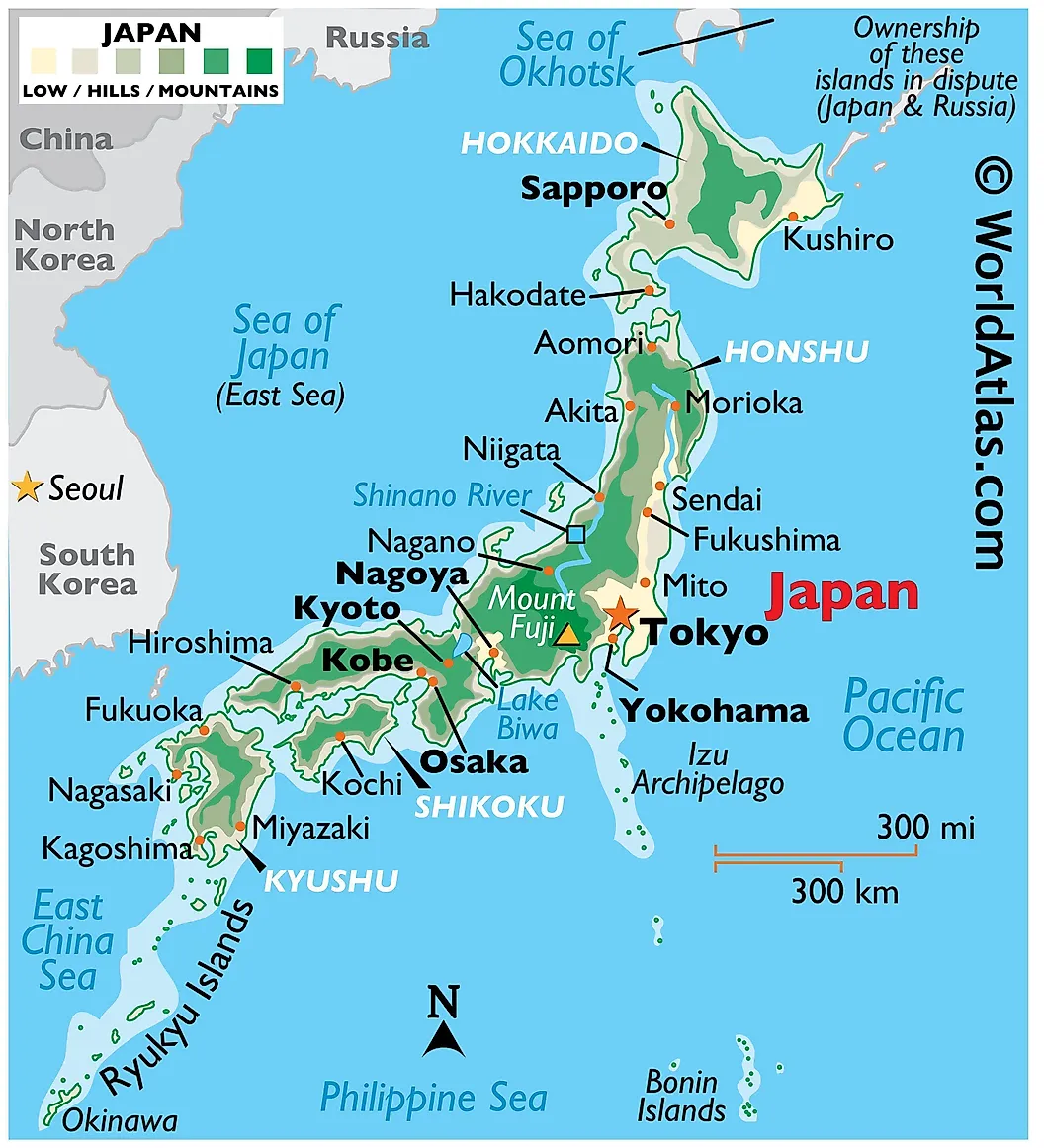
Japan's Location: (worldatlas.com) Japan is an East Asian country comprising a chain of islands between the North Pacific Ocean and the Sea of Japan, at the eastern coast off the Asian Korean Peninsula. It is located in the Northern and Eastern hemispheres of the Earth. The Island Nation stretches from the Sea of Okhotsk in the north to the East China Sea in the south. It is bordered by the Sea of Japan in the west. The country shares its maritime borders with North Korea, South Korea, Philippines, Taiwan, Russia and China.

Japan Info: (britannica.com)
The Japanese landscape is rugged, with more than four-fifths of the land surface consisting of mountains. There are many active and dormant volcanoes, including Mount Fuji (Fuji-san), which, at an elevation of 12,388 feet (3,776 metres), is Japan’s highest mountain. Abundant precipitation and the generally mild temperatures throughout most of the country have produced a lush vegetation cover and, despite the mountainous terrain and generally poor soils, have made it possible to raise a variety of crops. Japan has a large and, to a great extent, ethnically homogeneous population, which is heavily concentrated in the low-lying areas along the Pacific coast of Honshu.
Complexity and contrast are the keynotes of life in Japan—a country possessing an intricate and ancient cultural tradition yet one that, since 1950, has emerged as one of the world’s most economically and technologically advanced societies. Heavy emphasis is placed on education, and Japan is one of the world’s most literate countries. Tension between old and new is apparent in all phases of Japanese life. A characteristic sensitivity to natural beauty and a concern with form and balance are evident in such cities as Kyōto and Nara, as well as in Japan’s ubiquitous gardens. Even in the countryside, however, the impact of rapid Westernization is evident in many aspects of Japanese life. The agricultural regions are characterized by low population densities and well-ordered rice fields and fruit orchards, whereas the industrial and urbanized belt along the Pacific coast of Honshu is noted for its highly concentrated population, heavy industrialization, and environmental pollution.
Humans have occupied Japan for tens of thousands of years, but Japan’s recorded history begins only in the 1st century BCE, with mention in Chinese sources. Contact with China and Korea in the early centuries CE brought profound changes to Japan, including the Chinese writing system, Buddhism, and many artistic forms from the continent. The first steps at political unification of the country occurred in the late 4th and early 5th centuries CE under the Yamato court. A great civilization then developed first at Nara in the 8th century and then at Heian-kyō (now Kyōto) from the late 8th to the late 12th century. The seven centuries thereafter were a period of domination by military rulers culminating in near isolation from the outside world from the early 17th to the mid-19th century.
The reopening of the country ushered in contact with the West and a time of unprecedented change. Japan sought to become a modern industrialized nation and pursued the acquisition of a large overseas empire, initially in Korea and China. By late 1941 this latter policy caused direct confrontation with the United States and its allies and to defeat in World War II (1939–45). Since the war, however, Japan’s spectacular economic growth—one of the greatest of any nation in that period—brought the country to the forefront of the world economy. It now is one of the world’s foremost manufacturing countries and traders of goods and is a global financial leader.
Climate in Japan: (wiki) Most regions of Japan, such as much of Honshu, Shikoku and Kyushu, belong to the temperate zone with humid subtropical climate characterized by four distinct seasons. However, its climate varies from cool humid continental climate in the north such as northern Hokkaido, to warm tropical rainforest climate in the south such as the Yaeyama Islands and Minami-Tori-shima.
Japan's varied geographical features divide it into six principal climatic zones.
Japanese Language: (aboutworldlanguages.com) Japanese (Nihongo, 日本語) belongs to the Japonic language family. It is spoken as a first language by 122 million and as a second language by over 1 million people in Japan. It is also spoken in American Samoa, Argentina, Australia, Belize, Brazil, Canada, Dominican Republic, Germany, Guam, Mexico, Micronesia, Mongolia, New Zealand, Northern Mariana Islands, Palau, Panama, Paraguay, Philippines, Singapore, Taiwan, Thailand, United Arab Emirates, United Kingdom, and USA.The number of Japanese speakers worldwide is estimated at close to 123 million people (Ethnologue).
There have been numerous attempts to establish a genetic relationship between Japanese and other languages and language families. The most popular theory is that Japanese, like Korean, is a member of the Altaic language family. This suggests that Japanese and Korean are related, although extremely remotely. As far as Ainu, spoken in northern Japan, is concerned, there is no evidence that there is a relationship between Ainu and Japanese. Ainu is considered to be a language isolate.
In addition to Japanese, there are 14 Ryukyuan languages spoken in Okinawa and neighboring Ryukyu islands. These are mutually unintelligible with Japanese and, in most cases, also with each other. Since these languages cannot be understood by Japanese speakers as well as by speakers of other Ryukyuan varieties, some scholars in the past considered them to be separate languages. However, the prevailing view today is that they constitute a variety of Japanese.